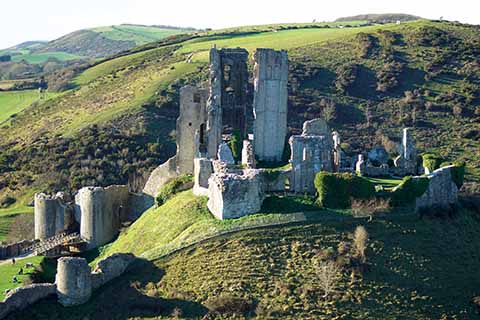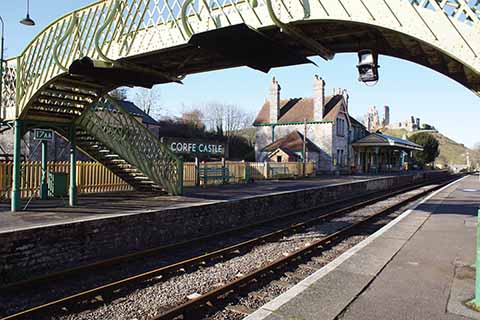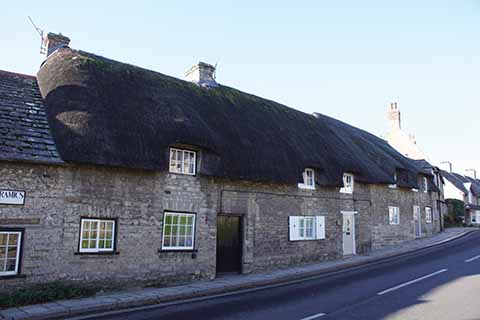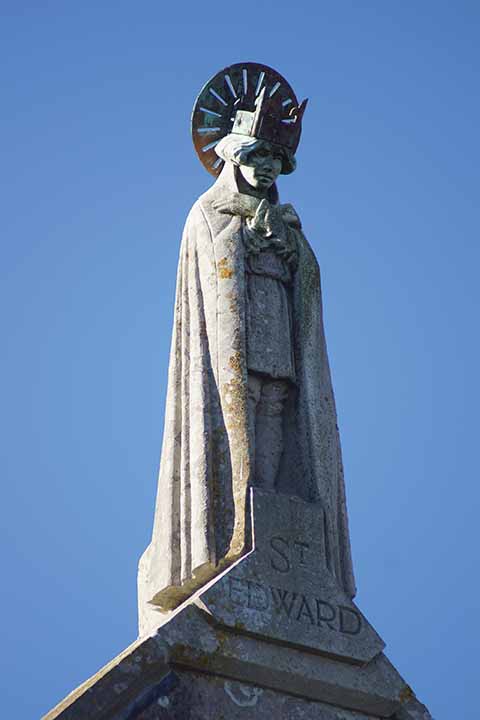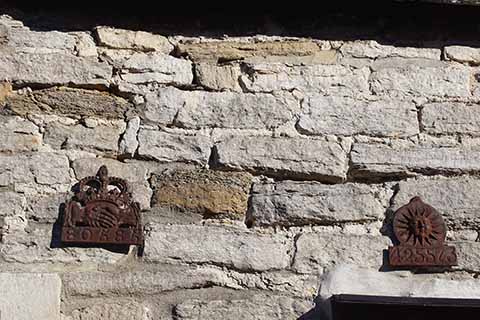Dorset village – Corfe Castle
Joël Lacey takes his camera for a walk around the settlement beneath the iconic Dorset landmark
Published in April ’19
Arthur Mee, in a chapter entitled ‘The Hilltop of a Thousand Years’ in his book The King’s England: Dorset enthused about the village thus: ‘Corfe. Is there anything else like it in England? If so we have not seen it. It is unique and beautiful. It clusters round a ruin of a throne, the walls of the castle rising magnificently to be seen for miles.
‘It dominated this place about a thousand years ago and it dominates it still, a ruin but majestic, high over all, shattered by shell and battered by time, yet still defiant of time and violence, an enduring monument of resistance, a page of rude history that thrusts itself on human notice.
The village itself, crouched beside this battered stronghold, fits superbly in the scene. It is at the heart of the so-called Isle of Purbeck, a primeval region ringed in part by the elemental heaths which caused a sombreness over the soul of their greatest son, and in part ringed in by stern cliffs and dangerous seas: a land of stony strength with an ever-present sense of ancient things. Where the heath is not the hills are, and every swell on the skyline of the hills has mysterious memories of vanished races and their entrenched camps.
‘Around Corfe a thousand years is as one day. The ground tints tone with the sense of antiquity. Corfe is a grey old town. Its lovely cottages and houses are grey, its taverns are grey stone with stone roofs. The church is grey, strong, enduring. So are the tall upreared ruins of the indomitable old castle. Everything to be seen from many points of view makes a consistent and satisfying picture.
‘To alter anything would be a mistake. Though the ruins are grim, the scene, with the town as part of it, is not hard. Time’s touch is softening, and there are lovely accompaniments in the profusion of Dorset flowers creeping over and cloaking the cottages. There is hardly a corner in Corfe that is not beautiful.’
Fifty years before Arthur Mee published these words, that most unflinching criticiser of the new, Sir Frederick Treves, wrote thus of Corfe: ‘Corfe Castle – on the high-road between Wareham and the sea – is the most interesting place in this traditional isle. The village is ancient and grey, a dim, mumbling place of tales and gossip. It has changed but little in the last century or so, and has remained unspoiled, although the canker of red brick has begun to gnaw at its vitals. It is a wrinkled old place in the winter of its age, lying at the foot of its Castle like a faithful hound. Its three little streets lead humbly to the Castle gate.
‘The keep rises high above the village, and looks down upon it as a sacred image would regard an adoring worshipper. The small town has ever been dependent upon the Castle, and is dependent on it still, for it brings to the place hungry tourists in charabancs, with their holiday money in their pockets.
‘The quiet, ever cool-looking, ever beautiful village of Corfe is all of one colour: a symphony in grey. If ever it boasted brighter hues, they have long since faded to one sober, ashen tint. It is a village of drab stone. The houses, all old, are for the most part low. The roofs of crumpled slabs are broken up by dormer windows, at which white curtains will be fluttering, or are crowned by chimneys of dun brick. Here and there is a stone porch with a little chamber over, whose diamond panes look up and down the street.
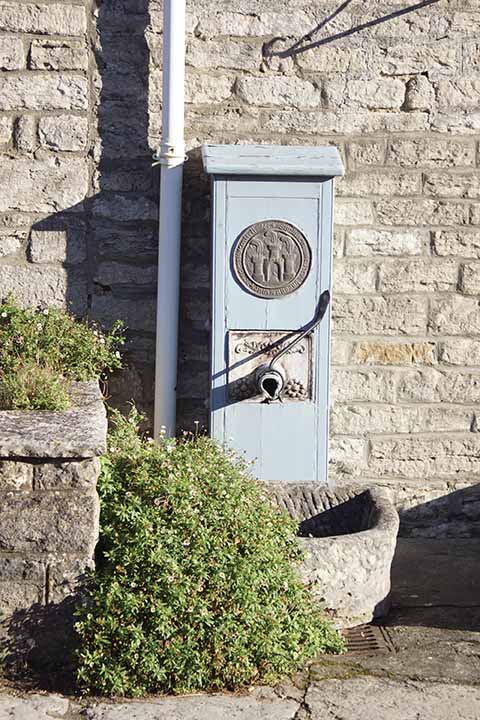
This water pump outside Grace Cottage on the main through road to Swanage is a near twin to the one at the base of the Market Cross between the church and the castle
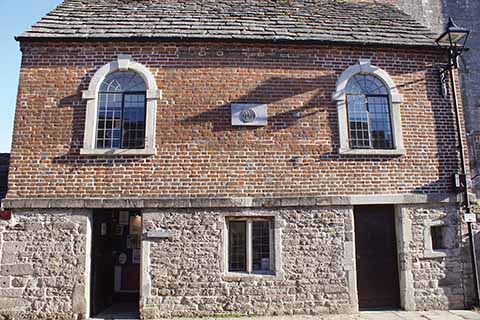
The town hall is easily recognisable from other Corfe Castle buildings with its stone/brick/stone construction
‘Even the humblest cottage may boast a strong buttress or an ancient outhouse of good masonry. Stone-mullioned windows are common, while gables and flagged courts have never been démodé in Corfe.
‘Opposite to the village cross is the Town House, with an especially fine bow window of many panes, capped by a roof of rugged stone. The inn has a porch with a small room over it, like a miniature house. This chamber is held up, with no little dignity, by three stone pillars, which have in their time afforded comforting support to the backs of many carters while they drank their cyder.
‘There is every phase of grey in Corfe, although the monotony of the colour never lacks relief. Ivy, or some warm, homely creeper covers the cold walls; white railings, a clump of hollyhocks or of fuchsias take away the primness from the door; there will be jessamine over the porch, dark green moss on the roof, and a tuft of yellow flowers growing in every hospitable cranny. In gentlest contrast of all will be the soft cheek of many a blushing rose laid against the worn ashen stone.
‘The little town has had numerous vicissitudes. It was once a self-contained place with considerable resources, as a return made in 1796 serves to show. At that time Corfe could boast of two persons “of independent fortune,” of eighteen farmers and sixteen shoemakers, of three breeches-makers, of a barber, a mole-catcher, a surgeon, a furze-cutter, and a hurdler, besides blacksmiths, painters, carpenters, and thatchers.’
Curious people seem to have wandered in those days into Corfe, where they were hospitably treated by the Mayor and Corporation. Of such the town records show entries after this fashion:
“1662. Gave two travellers, by Mayor’s order, 2d.” “1673. Gave to a traveller from Norfolk, 6d.” It will be noticed that the extreme remoteness of Norfolk demanded the addition of fourpence to the ordinary dole. Women, soldiers, and sailors were very kindly dealt with by the town of Corfe, as the subjoined make evident: “1668. To a woman whose husband was in slavery, 6d.”
“1686. Gave two seamen that were drove ashore at Chapman’s Pool, two Shillings.”
“1786. To a Soldier that had one arm, 1s.” Foreigners also in doleful plight found. their way into this out-of-the-way town, as the following will testify: ” 1682. Gave to 5 Dutchmen, by the Mayor’s order, 2s. 6d.”
“1686. Gave 10 Frenchmen 3s. 6d., which they spent at the George”.’
Neither Treves nor Mee mentions the railway. It was neither new enough to excite then, nor old enough to evoke childhood memories.
Now, though, the storybook nature of Corfe Castle is greatly enhanced by the Swanage Railway running through it. Rebuilt from nothing since 1976 – after being closed by British Rail in 1972 – it took just seven weeks to lift the six-and-a-half miles of track and almost thirty years to re-lay them; the track, locomotives, carriages and other equipment had to be brought in by road.
People have been plodding this way and that with beasts of burden and carts for time immemorial. There has been a settlement in the Corfe area for around eight millennia. The first recording of its name, in an AD 955 copy of an Anglo-Saxon charter, is as Corf, the Old English word for a cutting or a pass: as straightforward a description as one could find of the gap in the Purbeck Hills’ central ridge in which Corfe Castle sits. The suffix ‘Castle’ did not appear in its name until the beginning of the 14th century. It reverted to being a village from a town in 1989.
